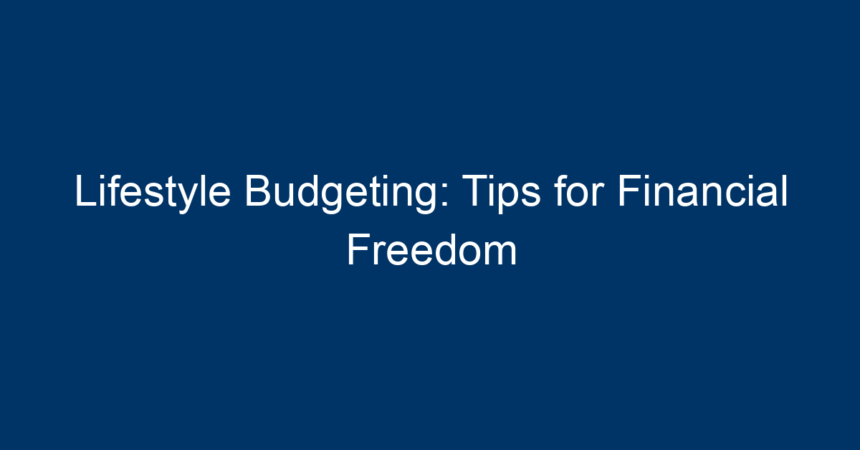In today’s fast-paced world, achieving financial freedom often feels like an elusive dream. However, with strategic planning and effective lifestyle budgeting, that dream can become a reality. This article dives into the concept of lifestyle budgeting, offering actionable tips that can help you gain control over your finances, reduce stress, and ultimately lead you toward a life of financial independence.
What is Lifestyle Budgeting?
Lifestyle budgeting is an approach that considers your personal values, goals, and the lifestyle you aspire to maintain. Unlike traditional budgeting methods that focus solely on cutting costs, lifestyle budgeting emphasizes creating a financial plan that aligns with your life’s objectives. By incorporating your desired lifestyle into your budgeting plan, you can enjoy the present while also planning for the future.
Benefits of Lifestyle Budgeting
- Holistic Approach: This method acknowledges your personal desires and needs, unlike rigid budgeting methods.
- Flexibility: Lifestyle budgeting allows room for adjustments, making it easier to adapt to changing circumstances.
- Motivation: When you see your budget aligned with your goals and aspirations, it becomes a source of motivation rather than a constraint.
Understanding Your Income and Expenses
Analyze Your Income
The first step in lifestyle budgeting is to have a clear understanding of your income. It’s not just about your salary—consider all sources of income, including:
- Bonuses
- Side hustles
- Investments
- Passive income streams
This comprehensive view will form the foundation of your budget.
Track Your Expenses
Next, you need to categorize your expenses into fixed, variable, and discretionary.
- Fixed Expenses: These are recurring costs like rent, mortgage, or insurance.
- Variable Expenses: These costs can fluctuate, such as groceries, utilities, and transportation.
- Discretionary Expenses: These are non-essential, like dining out, entertainment, and shopping.
Consider using budgeting apps to keep tabs on your spending. This tracking will provide valuable insights into where your money goes and highlight opportunities for adjustment.
Setting Financial Goals
Short-term Goals
These are achievable within a year and can include:
- Saving for a vacation
- Paying off small debts
- Building an emergency fund
Long-term Goals
These goals often extend beyond a year, including:
- Home ownership
- Retirement planning
- Wealth accumulation
Set SMART goals—Specific, Measurable, Achievable, Relevant, and Time-bound. This ensures clarity and focus in your budgeting efforts.
Creating Your Lifestyle Budget
Determine Your Priorities
Based on your financial goals, establish what’s most important to you. Whether it’s travel, education, or savings, recognizing your priorities will allow you to allocate funds more effectively.
Allocate Your Income
Using the 50/30/20 rule can serve as a great foundation for your lifestyle budget:
- 50% for Needs: This includes essential expenses such as housing, food, and utilities.
- 30% for Wants: Allocate this portion for entertainment, hobbies, and vacations.
- 20% for Savings and Debt Repayment: Focus on building your savings, retirement funds, and paying down any debts.
Adjust as Necessary
Your lifestyle budget should be a living document. Regularly review and adjust it as your life circumstances change, income fluctuates, or goals evolve.
Tips for Successful Lifestyle Budgeting
Embrace Minimalism
Many people find happiness in experiences rather than material possessions. By embracing minimalism, you can reduce unnecessary spending and focus on what truly adds value to your life. Ask yourself if each purchase aligns with your financial goals.
Make Use of Technology
There are numerous budgeting apps available, such as Mint, YNAB (You Need A Budget), and PocketGuard. These tools can streamline the budgeting process and help you track your progress effortlessly.
Review Regularly
Schedule monthly financial reviews to analyze your budget’s performance. This practice allows you to celebrate your successes and identify areas that require improvement.
Build an Emergency Fund
A crucial component of financial freedom is having a safety net. Aim to save three to six months’ worth of living expenses. An emergency fund can help you avoid going into debt during unforeseen circumstances.
Engage in Continuous Learning
Financial literacy is key to successful lifestyle budgeting. Read books, attend seminars, or follow financial blogs to keep updated on best practices and new strategies.
Overcoming Budgeting Challenges
Emotional Spending
Many individuals struggle with emotional spending—using shopping as a coping mechanism for stress. To combat this:
- Identify triggers and find alternative coping strategies, such as exercise or meditation.
- Set a waiting period before any non-essential purchase to assess whether it’s truly needed.
Peer Pressure
Sometimes, social norms can lead to overspending. Remember, it’s okay to decline invitations that don’t fit your budget. Suggest alternative gatherings that are budget-friendly—like potlucks or outdoor activities.
Financial Setbacks
Life is unpredictable, and financial setbacks can happen. The key is not to get discouraged. Review your lifestyle budget, adjust your goals if necessary, and focus on moving forward.
Conclusion: Your Path to Financial Freedom
Achieving financial freedom through lifestyle budgeting is not only possible but also empowering. By understanding your income and expenses, setting clear financial goals, and creating an adaptable budget, you can align your spending with your values and aspirations.
The journey requires commitment and regular reviews, but the benefits far outweigh the challenges. Take control of your financial destiny today—begin your lifestyle budgeting journey, and pave the way toward a more secure and fulfilling future. Remember, financial freedom isn’t just a destination; it is the lifestyle you cultivate along the way. Start budgeting today for a brighter tomorrow!




